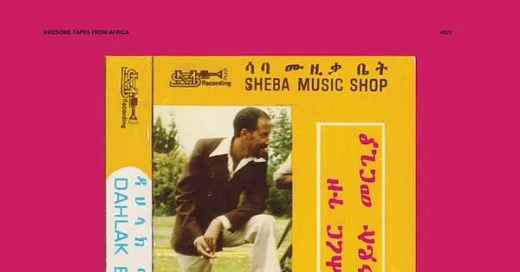EVERY GENRE PROJECT - March 21 - Ethio-Jazz
Genre of the Day - Ethio-Jazz
Album of the Day - Wede Harer Guzo by Hailu Mergia (1978)
March 21, 2024
You really never know what genre is going to catch on far abroad, thousands of miles flung from the little nestles that it sprung forth from. As I said yesterday, the death metal of rusting industrial towns in Britain becoming a stronghold in affluent Scandinavian cities is one head-scratching example. Though jazz exists as perhaps the first true American music fusion genre, its first few decades in existence also happened to coincide with the advent of recorded music. Thus, it spread to every corner of earth, adding their own flair. Today's example wasn't even transmitted through an American conduit. Out of all, though, Ethiopian jazz emerged as one of the most unique strains of global jazz music and remains a towering name among music geeks and the exceedingly pretentious.
It’s only fitting in a country so noted for its lengthy history and lines of emperors that Ethiopian jazz can pretty much single handedly be sourced to an appointment made by the famed Haile Selassie himself as well as a niche, international tidbit involving Armenia. The well-travelled Haile Selassie was particularly inspired by the plight of the Armenian Genocide, as after seeing a group of Armenian orphans performing on a visit to Jerusalem, he decided to take them to Ethiopia for further musical instruction under the tutelage of Kevork Nalbandian. His nephew Nerses Nalbandian would then be appointed in the mid-’50s as the director of the Ethiopian National Theatre. It was there that he sought to combine the best of traditional Ethiopian music and Western instrumentation, enchanting the minds of the Ethiopian public and aspiring musicians who have continued the tradition since. Crazy how Armenia figures everywhere, from the Kardashians to Ethiopian jazz.
Mulatu Astatke was the figure that would take the foundation laid by Nalbandian to condense the fusion between western and Ethiopian musical influence and take Ethio-jazz to new heights. Combining the five note scale of Ethiopian traditional music with western instrumentation, he successfully achieved what we’ve seen many genres in this column do: toe the delicate balance between nostalgia and newfangled innovation to make a musical product greater than the sum of its precursors. Hailu Mergia makes the album contribution today, though: while there was another available album on Spotify ranked higher, it was some bizarre fusion of art punk with Ethio-jazz, and I’m just not letting that define Ethiopian jazz for today’s column. Both Astatke and Mergia just released new tracks in 2020: the genre is alive and well and has absorbed new trends and genres acceptingly, even through many tribulations such as the dictatorship from 1974-1987.
Today’s album peeks out through a thick layer of recording fog, as is often the case with some of these Spotify rips or simply the quality of the original recording. Fortunately, these funk-influenced melodies have not lost their splendor. The plaintive singing that appears on opener “Embuwa Bey Lamitu” is a red herring, as the rest of the album features sunny but never saccharine, perfectly funky grooves. “Bati Bati” feels like a jazz sibling to reggae trends at the time, with its wandering keyboard, sharp guitar licks, and roiling bass. But throughout the album, the constant interplay of melodies and creativity in improvisation defines Ethiopian jazz’s prowess. “Yene Nesh Wey (Amalele)” is one of the best tracks in this regard with its particular synergy in the keyboard, guitar, horn section, and bass’ conversations. The joyful la-la-las of “Wede Harer Guzo” marries the best of traditionally communal singing to energized jazzy gusto and icy electric piano. It’s a fantastic listen, really: no wonder people would stay up until sunrise just to hear.




